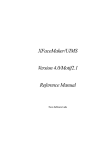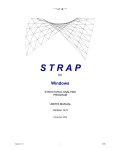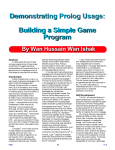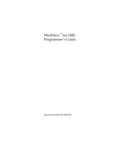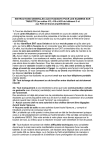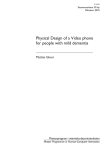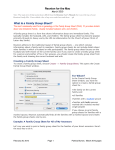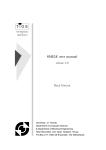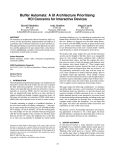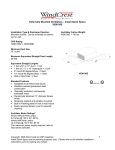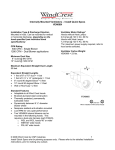Download VDL — a View Definition Language
Transcript
VDL — a View Definition Language Mats Johnson, Erik Borälv Center for Human-Computer Studies Uppsala University Lägerhyddvägen 18 S-752 37 Uppsala SWEDEN VDL is a language for specifying user interfaces. The basic approach of the language is specifying attribute/value pairs for a hierarchy of user interface objects. The language is declarative and puts an emphasis on expressive power through the use of inheritance, parameters and variables. 1. Introduction When describing a graphical user interface it is useful to use attribute/value pairs. The exact look and behaviour of a certain user interface object can be described using a set of such pairs. A complete user interface consists of a hierarchy of interface objects, and a description of such an interface can therefore be a hierarchy of sets of attribute/ value pairs. 1.1. The X Resource Manager An example of using attribute/value pairs for describing a user interface is the X Resource Manager, Xrm [4]. A specification might look like this: Strings in the hierarchy specification refer either to the names or the classes of the components. In order to make the specification language more expressive, wildcards are allowed in the first part, the hierarchy specification. A “?” matches any single component name or class, and a “*” matches any number of components, including none. When more than one specification would be applicable, the more specific take precedence. A specification using wildcards could look like this: *bar.foreground: green This means that any component called bar will have the foreground set to green, unless overridden. top.foo.bar.foreground: red The first part specifies where in the hierarchy this attribute/value pair belongs, in this case in the bar object, within the foo object, within the top object. The next part is the attribute name, foreground, followed by the value, red. Shortcomings. A specification of a user interface using the X Resource Manager becomes very large. The hierarchy specification to the left of the colon is repeated identically in a large number of lines. The line-oriented style makes the specification rather unreadable. The expressiveness gained by using wildcards is not powerful enough. There are no “modules”. It is normally not possible to specify the component hierarchy using Xrm. It is assumed that the widget hierarchy is created programmatically. There is however a library called Wcl [7] which adds the possibility of specifying the hierarchy in a resource file. It basically works by adding the resource wcCreate, which defines the class name of the widget, and the resource wcChildren which has as its value a list of names of children to be created. Mri.wcChildren: *push.wcCreate: *push.labelString: *push.activateCallback: For setting attributes of widgets there is another view consisting of dialogue boxes with very long lists of attribute/value pairs. These dialogues are accessed through one of the hierarchy views. The high level, direct manipulation, WYSIWYG editing is in practice only used on demos and exhibitions. The problem is that such views are simply not appropriate for the designer who need more information about and quick access to the widget hierarchy. The high level interfaces also cannot possibly provide direct access to the many attributes. In practice the hierarchy view together with the attribute list dialogue boxes are used. This makes for lots of clicking and scrolling through lists of attributes. It is also difficult to achieve good modularisation and reuse. User interface specifications are complex, almost as complex as computer programs. To cope with the complexity certain mechanisms are needed which do not lend themselves easily to graphic representation. Just as with programming languages it may be that it is more efficient to use a textual representation. push XmPushButton Hello World WcExit Figure 1: Example of a Wcl specification and the output it generates. Xmt [5] is another library which adds the same capability in a somewhat different fashion. 1.2. Other tools “Graphical” tools such as TeleUSE [6] allows the specification of the widget hierarchy in a declarative way, just as Xrm and Wcl. On the surface they seem to provide an attractive direct-manipulation interface to the user interface specification. There are usually several levels of access possible to the specification, as well as some kind of test mode where buttons can be pressed and menus pop up. The highest editing level looks the same as the resulting interface will, but is not “live”, instead some editing is possible. The next level is a view of the widget tree structure indicating the names and types of the widgets. Finally there is a text representation of the specification (in principle the same level as Xrm with Wcl). 2. The View Definition Language VDL uses the same basic concept as Xrm. The present implementation generates resource files for use with Wcl. In order to overcome the problems with the X Resource Manager, VDL adds structure, inheritance, parameters, variables and functions. The actual syntax used in the examples, and in the current implementation is influenced by our use of Perl [3] as the implementation language. This syntax is not necessarily the best or the most elegant. 2.1. Attributes The most basic construct in the language is the definition of a constant value for an attribute. foreground:red 2 The value of the attribute foreground is defined to have the value red. 2.5. Hierarchy inherit Variables and attributes access values at the same level of hierarchy, unless an explicit argument is given to val indicating how many levels up in the hierarchy the value should be fetched from. 2.2. Structure In VDL, the description of the sets of attribute/value pairs for the complete hierarchy of components forming a user interface is broken up into templates, or styles, describing a part of the hierarchy. A definition of such a style consists of a name, a parameter list and a sequence of definition items. It is an ordered sequence; items that come later in the sequence override earlier ones. The simplest kind of definition item is one that defines a constant value for an attribute. foo:background:val(colour, 1). Here foo is defined to have the same background as its parent component in the hierarchy. 2.6. Inheritance A style can inherit all attributes (and variables) from another style. bar:foo, background:green. foo:foreground:red, background:yellow. Here the style bar is defined, inheriting attribute/value pairs from foo, and adding a pair of its own. Definitions later in the sequence take precedence over earlier ones, including inherited definitions. In this example, a style foo is defined, with two definition items, specifying that foreground is red and background has the value yellow. 2.7. Hierarchy 2.3. Values of other attributes The hierarchical structure is specified in VDL by naming a child and providing a definition. The value of an attribute can be defined to be the same as the value of another attribute. foo:foreground:val(background). foo:cld(a, bar), cld(b, bar, background:green). The value of foreground is defined to be the same as the value of background. This defines a style foo, describing a hierarchy with two children, named a and b. Both children inherits attributes from the style bar, but the second child b declares background to be green, overriding any value inherited from bar. 2.4. Variables Variables are like attributes, except that they do not generate any output themselves, but only act as placeholders. 2.8. Bigger example of the above foo:colour=red, background:val(colour). 2.9. Parameters In this example, the variable colour is defined with a value of red. The attribute background uses the variable colour. This results in background having the value red. There is no attribute colour generated. There is also the option of using parameters when inheriting. Parameter values are accessible inside the whole definition of a style, but not from anything inherited. 3 foo(bg):foreground:red, background:val(bg). bar:foo(blue). to the user. The controls are objects responsible for maintaining the mapping between presentation and abstraction. The style foo is defined to take one parameter, bg, and uses it for the value of background. The style bar inherits from foo, passing a parameter of blue. The result is that bar gets a background of blue, and a foreground of red. 3.2. Support for CAOS in VDL 2.10. Functions Structure. Using CAOS means that it is known what abstraction is going to be presented by a given layout. For example, a layout meant to present an employee is only meaningful when used for exactly that purpose. Trying to use it for presenting a purchase order will result in chaos. Therefore it makes sense to structure the layouts according to abstraction. This structure is achieved by appending the name of the abstraction to be presented to the name of the VDL style. When using (inheriting from) such a layout the abstraction part of the name is automatically derived from the context established by the controllers annotating the presentation. In order to support CAOS the hierarchy described by VDL must be annotated with control objects. Knowledge about the abstractions is also used by VDL to improve expressiveness. Sometimes the value of an attribute needs to be a function of some other value. foo:font:[weight(val(font), bold)], foreground: [darker(val(background), 30)]. Here the font is defined to be the same as before, but bold, and the foreground to be the same colour as the background, but darker. In this example the function definition is expressed in Perl [3], since this is the implementation language of our prototype. 3. CAOS in VDL VDL was designed to be useful on its own, but also to support the CAOS [1] model of dialogue design. Big/Employee(bg):- … . Big/Purchase(bg):- … . Here a layout for an employee is defined and another one for a purchase order. Both are named Big. Both layouts are referenced using the name Big: 3.1. What is CAOS CAOS is an implementation model for object oriented user interfaces. It extends the well-known PAC [2] model with more detailed knowledge of the application, resulting in less effort to implement dialogues, and more power in the underlying support system. This in turn results in less expensive user interfaces with higher quality, and increased consistency. In the CAOS (and PAC) model there are three important parts: presentation, abstraction and control. The presentation corresponds to the hierarchy of user interface objects described by VDL. An abstraction is an object (in the object-oriented sense) that represents the data that should be presented … cld(emp, ctl(Object, get_employee), Big), cld(pur, ctl(Object, get_purchase), Big), … The presentation actually used depends on the context established by the controllers. Since get_employee returns an abstraction of class Employee and get_purchase returns an abstraction of class Purchase, the VDL compiler knows where to find the correct presentation. 4 Controls. Controls are specified in VDL in a manner similar to children. creation of popups in a manner similar to ordinary children. Big/Employee:cld(name, ctl(Object, get_name), Small), … . MenuBar:pup(fileMenu, Pulldown(…), …). The layout MenuBar has a popup called fileMenu which inherits from Pulldown. A layout for an employee is defined here, named Big. It has a child named name with an Object controller. The controller has a navigation specification of get_name. The child inherits from Small. There can be more than one controller, but all controllers must be specified before any other definition items. VDL has access to information about the abstraction structure, and knows what abstraction a method returns. The controller specifications are used to calculate what abstraction every style is presenting. This information is then used when looking up layouts with names containing the abstraction name. 4.3. Siblings In Motif, convenience (or confusion) functions are often used. With Wcl the names of these functions can be used as values of the wcCreate attribute, just like the names of widget classes. The problem with these functions is that they often create more than one widget. It is even so horrible that the top-level widget of the widget tree they create is not given the name it was asked to use. foo:cld(bar, XmCreateScrolledList, items:”First, Second, Third”, itemCount: 3). Here one might expect the creation of a child called bar of widget class XmScrolledList, that gets the attributes items and itemCount set. What happens is instead that a child named barSW of type XmScrolledWindow is created. This widget in turn has a child called bar of type XmList. The attributes defined therefore end up at the wrong level. To solve this problem the concept of sibling is introduced. If a layout defines a sibling, it will be handled like a child, except that its attributes will be output as if it was a child of the parent instead. 4. Wcl in VDL In the prototype implementation there is some specific support for Wcl and Motif. 4.1. Inherit from widgets If a form inherited from is not found, this is interpreted as a Wcl declaration of what Motif widget class should be used to create the component. This is accomplished by setting the value of the wcCreate attribute. label(txt):XmLabel, labelString:val(txt). The layout label is defined to inherit from XmLabel. Since no such layout has been defined, this has the same effect as setting the wcCreate attribute to XmLabel. This technique makes it possible to create a definition for XmLabel later to override the builtin defaults of Motif. foo:cld(bar, XmCreateScrolledList, sib(barSW, cld(bar, items:”First, Second, Third”, itemCount:3))). This is how sibling is used to solve the problem. The behaviour of XmCreateScrolledList is modelled, and there is even a way of setting attributes on barSW. Note that there is no widget class specification in either the sib(barSW…) or the cld(bar…). 4.2. Popups In Motif there is a second set of children to a widget called popups. VDL supports the 5 That is already taken care of by XmCreateScrolledList. There is no point in defining any attributes on the child that contains inh(XmCreateScrolledList). 5. References [1] Mats Johnson, CAOS, an extended object oriented model for dialogue design. [2] Joelle Coutaz, PAC, an Object-Oriented Model for Dialog Design, in Proceedings of IFIP INTERACT’87: pp. 431-436, 1987. [3] The Perl language http://www.perl.com/perl/ [4] Adrian Nye, Volume 2: Xlib Reference Manual, 3rd Edition June 1992, 1138 pages, ISBN: 1-56592-006-6, O’Reilly & Associates, Inc. [5] David Flanagan, Volume 6C: Motif Tools, Streamlined GUI Design and Programming with the Xmt Library, 1st Edition August 1994, 1024 pages, ISBN: 1-56592-044-9, O’Reilly & Associates, Inc. [6] TeleUSE User Manual. [7] Adrian Nye, David Smyth, Wcl 2.0: the Widget creation Library, The X Resource issue 2, O’Reilly & Associates, Inc., Spring 1992. 6






